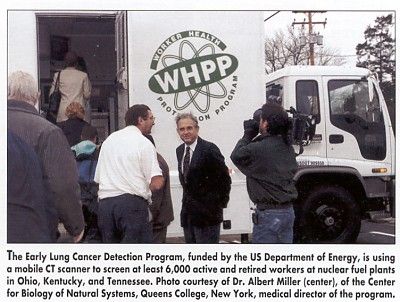Project Will Screen Nuclear Fuel Workers for Lung Cancer Using CT
NEW YORK-More than 6,000 nuclear fuel workers in three gaseous diffusion plants will be screened for lung cancer using single-slice helical low-dose CT scans in a project funded by the US Department of Energy, said the program’s medical director, Albert Miller, MD, Center for Biology of Natural Systems, Queens College, City University of New York.
NEW YORKMore than 6,000 nuclear fuel workers in three gaseous diffusion plants will be screened for lung cancer using single-slice helical low-dose CT scans in a project funded by the US Department of Energy, said the program’s medical director, Albert Miller, MD, Center for Biology of Natural Systems, Queens College, City University of New York.
Asbestos, Uranium, Beryllium
Launched last November, the Early Lung Cancer Detection Program expects to enroll a minimum of 2,000 active and retired workers annually for the next 3 years at plants in Ohio, Kentucky, and Tennessee, Dr. Miller said at the 4th International Conference on Screening for Lung Cancer. The Paper Allied Industrial Chemical and Energy Workers International has signed on as a sponsor of the project, he added.
"These workers have been exposed to asbestos," Dr. Miller said. "On screening x-rays, more than 10% have changes indicative of asbestos disease. They’ve been exposed to radiation in the form of alpha particles of uranium and transuranium elements, to gamma radiation and neutrons, and to beryllium, which is another lung carcinogen."
Persons 50 years of age or older with a smoking history or who have worked at least 5 years in a potentially exposed trade in a Department of Energy facility are eligible for the study. Persons with evidence of beryllium or asbestos disease may be enrolled at younger ages, Dr. Miller noted.
A mobile CT scanner makes the rounds of the plants (see Figure). "We also have the potential for a comparison population in a fourth state, in which the population is only undergoing basic screening," he said. Basic screening includes medical history and history of occupational exposures, respiratory questionnaire, physical exam, chest x-ray, spirometry, and beryllium lymphocyte transformation testing.

In the first 500 low-dose CT scans, the breakdown of findings was similar at the three sites, Dr. Miller reported. Nearly half of the individuals screened had no nodules, about 18% had calcified nodules, and 25% had indeterminant nodules. Follow-up with high-resolution CT on the indeterminant nodules found that about one third had either disappeared or were calcified, Dr. Miller said.
Referred for Workup
The seven persons whose CT scans revealed suspicious nodules were referred to local medical practitioners for further workup and possible interventions.
Of the five persons for whom Dr. Miller had received reports at the time of the presentation, two were diagnosed with stage IA lung cancer and one was diagnosed with a metastasis from a known bladder carcinoma.
An advantage of the program over other occupational surveys on which Dr. Miller has worked is that radiologic follow-up of the indeterminant nodules is assured. "When it is left to the insurance companies and to managed care, they are very reluctant to have these CT scans done," he observed, "and very few workers in those other surveys did get the follow-up they needed."